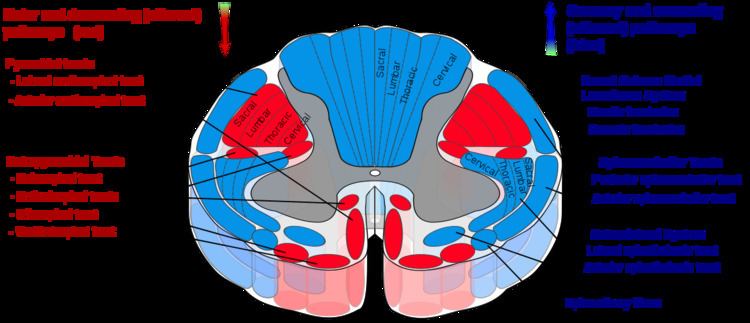NeuroNames ancil-2137625602 | ||
 | ||
Latin Tractus spinocerebellaris | ||
The spinocerebellar tract is a set of axonal fibers originating in the spinal cord and terminating in the ipsilateral cerebellum. This tract conveys information to the cerebellum about length and tension of muscle fibers (i.e., unconscious proprioceptive sensation)
Contents
Origins of proprioceptive information
Proprioceptive information is obtained by Golgi tendon organs and muscle spindles.
All of these neurons are "first order" or "primary" and are sensory (and thus have their cell bodies in the dorsal root ganglion). They pass through Rexed laminae layers I-VI of the dorsal horn to form synapses with "second order" or "secondary" neurons in the layer just beneath the dorsal horn (layer VII).
Subdivisions of the tract
The tract is divided into:
Pathway for dorsal and spinocuneocerebellar tracts
The sensory neurons synapse in an area known as Clarke's nucleus or "Clarke's column".
This is a column of relay neuron cell bodies within the medial gray matter within the spinal cord in layer VII (just beneath the dorsal horn), specifically between T1-L3. These neurons then send axons up the spinal cord, and project ipsilaterally to medial zones of the cerebellum through the inferior cerebellar peduncle.
Below L3, relevant neurons pass into the fasciculus gracilis (usually associated with the dorsal column-medial lemniscal system) until L3 where they synapse with Clarke's nucleus (leading to considerable caudal enlargement).
The neurons in the accessory cuneate nucleus have axons leading to the ipsilateral cerebellum via the inferior cerebellar peduncle.
Pathway for ventral and rostral spinocerebellar tracts
Some neurons of the ventral spinocerebellar tract instead form synapses with neurons in layer VII of L4-S3. Most of these fibers cross over to the contralateral lateral funiculus via the anterior white commissure and through the superior cerebellar peduncle. The fibers then often cross over again within the cerebellum to end on the ipsilateral side. For this reason the tract is sometimes termed the "double-crosser."
The Rostral Tract synapses at the dorsal horn lamina (intermediate gray zone) of the spinal cord and ascends ipsilaterally to the cerebellum through the inferior cerebellar peduncle.
